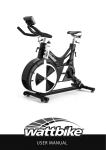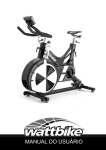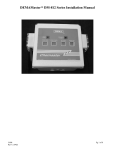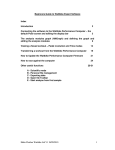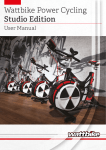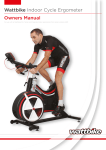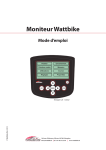Download Wattbike On-site Workshop
Transcript
Wattbike On-site Workshop Contents Introduction..........................................................................................................................................................................................3 Aims of the workshop........................................................................................................................................................................3 Workshop Outline...............................................................................................................................................................................4 What does a Wattbike do?................................................................................................................................................................5 Bike set up.............................................................................................................................................................................................6 Using the Wattbike Performance Computer...............................................................................................................................7 Pedalling Technique...........................................................................................................................................................................8 Gearing and Resistance.....................................................................................................................................................................9 Wattbike Pro – table.........................................................................................................................................................................11 Wattbike Trainer – table..................................................................................................................................................................11 Warming up........................................................................................................................................................................................12 Submaximal Ramp Test and 10’ Progress Check.....................................................................................................................14 10’ Progress HR Observation.........................................................................................................................................................18 Heart rate and power training zones..........................................................................................................................................18 Care of the Wattbike.........................................................................................................................................................................21 What’s next?....................................................................................................................................................................................... 22 Workshop notes................................................................................................................................................................................ 22 2 Introduction Welcome to the Wattbike Introductory Workshop. This represents the culmination of a number of years work, monitoring cyclists, triathletes and fitness enthusiasts on the Wattbike, and has been re-written many times to try and enable the science behind performance to be explained in a way that is accessible to all, without compromising the quality of the content. We have also developed expanded training and testing guides which are available from our website, created by Wattbike’s resident Sport Scientist, Eddie Fletcher, who has been testing, monitoring and training athletes around the world over the past few years. Each of the performance tests within the guides have been based on providing the answer to a specific question, how to assess an individual to establish their heart rate and power training zones to be able to monitor performance. In some cases new testing protocols have been developed as there had never been a testing tool like the Wattbike available before. We hope that today you can see how effective the Wattbike is when training, testing and improving physical ability. Aims of the workshop • • • • • • • Understand how the Wattbike works and how to set up a rider correctly Use the Wattbike Performance Computer (WPC) and scroll through the different screen options including linking heart rate monitors to the WPC Understand the importance of pedalling technique Understand how resistance and cadence works on a Wattbike Conduct a warm up and submaximal test on the Wattbike Know how to take care of your Wattbike (physically and technically) Know how to have fun on a Wattbike 3 Workshop outline 10.00 - 10.15 10.15 - 10.35 10.35 - 10.55 10.55 - 11.15 11.15- 11.25 11.25-11.45 11.45-12.30 12.30 - 12.45 12.45-13.00 13.00 - 13.15 13.15-13.45 13.45 - 14.00 Introduction, registration, welcome How the Wattbike works and Bike set up Using the WPC Pedalling Technique How to use the resistance settings Warm up Introduction to Fitness Testing Break 10’ Progress check Care of your Wattbike Having fun on the Wattbike What’s next? & Q and A workshop, close Contact details Wattbike Head office: 0115 945 5450 Email: [email protected] Wattbike Ltd Vermont House Nottm Sth & Wilford Ind Est Nottingham NG11 7HQ Extended Training Guide http://wattbike.com/uk/guide For information, help, complaints, feedback, bookings, sales please use these contact details. 4 What does a Wattbike do? The Wattbike measures absolute mechanical power in Watts (a measure of how quickly work is done). The amount of power produced is measured from the force applied to the chain through the cranks. The Wattbike is factory calibrated and does not need recalibrating. It is very accurate and has a mean accuracy typically within 2%. It samples the force data 100 times a second recording data for each pedal revolution. It also measures 42 different cycling parameters. Not all the parameters are visible on the Wattbike Performance Computer but the main parameters that are needed to monitor and analysis performance are contained within the Wattbike Performance Computer. The most up to date Wattbike Performance Computer (known as Monitor B) shows every pedal revolution live and has many of the parameters and analysis functions built into the screens. What’s the difference between the Wattbike Pro and the Wattbike Trainer? There are two Wattbikes, the Pro and the Trainer. Both Wattbikes have the same measurement system, accuracy, Performance Computer and Wattbike Expert software functions and deliver a professional range of cadence/power outputs. The only difference is the resistance range. The Trainer is low to medium resistance whilst the Pro is medium to high resistance. There is an overlap from the Trainer to the Pro at the medium level. At each equivalent resistance level and cadence the Trainer power output (W) is approximately 57% of the equivalent output on the Pro. Simply put, if cycling at 90 cadence on the Wattbike Trainer at resistance level 1 power output is 85 W and at resistance level 10 225 W. On the Wattbike Pro resistance level 1 at 90 cadence delivers 150 W and at resistance level 10 390 W. How to choose the right Wattbike The choice is easier to make if the Wattbike is for individual use. If it will be used by others (family members, young adults/children) then the choice invariably will be the Wattbike Trainer as this gives the lower resistance ranges that will be needed for effective exercise by noncyclists and children. The Wattbike Trainer is the preferred model for most people, as they can use the combination of the air brake and the magnetic brake to replicate any desired power to meet practical exercise and training needs. For riders who need higher resistance settings and for sprinters the Wattbike Pro is probably more appropriate. 5 Bike Set Up It is important that to set up a safe and comfortable cycling position. The correct set- up is crucial to maximise performance, prevent injury and ensure the most comfortable riding position on the Wattbike. Set up takes account of various body shapes, bone length discrepancy, flexibility/ core strength and injury history. The correct sequence for set up is, saddle height, saddle fore/aft position, handlebar height and handlebar fore/aft position. Before starting, ensure that the saddle is parallel to the floor; use a spirit level if necessary. Saddle Height The easiest way to get a rough height for the saddle height is to stand the rider next to the bike with the heel pushed into the back stabiliser, and then lift the saddle up so that the top of the saddle is level with the boney protrusion of the hip. Sit the rider on the Wattbike and align the crank arms with the seat post, place the heel of the foot on the crank arm nearest the floor – the leg should be straight (but not locked out). When clipped in (or with feet in the toe clips) and with the pedal at its longest stroke (in line with the seat post) there should approximately 25-30 degrees bend on the knee. The rider should be able to ‘drop the ankle’. Raise/lower the saddle height to get the correct leg position. ALWAYS DISMOUNT THE WATTBIKE BEFORE MAKING ADJUSTMENTS TO THE SADDLE. Now get the rider to pedal backwards, they should be able to complete rotations with only a slight rocking of hips and without the legs locking out. Saddle fore/aft Position With the feet clipped in (or in the toe clips) bring the crank arms parallel to the floor, drop a plumb line from the inside of the knee, in the indentation next to the patella - it should bisect the pedal spindle. Adjust the saddle fore/aft to ensure that the knee is over the pedal spindle. NOTE – if you need to move the saddle fore/aft severely, you may need to raise/lower the saddle to compensate The difference between the forward and back positions of the saddle fore/aft adjustment is 6 cm. Handlebar Height (Saddle to Handlebar Difference) Adjust the handlebar height so that it is no more than 4 to 10 cm lower than the saddle height (depending on fitness and flexibility, a higher handlebar height may be more comfortable) – for general exercise classes the saddle and handlebars should be at the same height - Use a long spirit level from the saddle across to the handlebar to set this height. Once the handlebar height has been set, check it by asking the rider to lift their hands off the handlebars – they should be able to hold position. NOTE – with the saddle and handlebar both set at maximum height there is a saddle to 6 handlebar difference of 7 cm – for safety reasons do not go above minimum markings – extralong stems are available which increase the settings by 10 cm. Handlebar fore/aft Position Ask your participant to place their hands on top of the handlebars and bring the crank arms parallel to the floor – drop a plumb line from the elbow, it should fall through the inside of the knee, in the indentation next to the patella and should bisect the pedal spindle – adjust handlebars fore/aft to get the correct position. ALWAYS DISMOUNT THE WATTBIKE BEFORE MAKING ADJUSTMENTS TO THE SADDLE OR HANDLEBARS. An alternative method is to look at the angle of the back which should be at 45° parallel to the floor with an upper arm to torso angle of 90°. The difference between the forward and back positions of the handlebar fore/aft adjustment is 6 cm. By following these simple steps the rider will be placed in the optimum position for both comfort and effective cycling technique. Any slight variation in correct set up will alter the alignment of the joints, muscles and subsequently technique. Ensure that you follow these simple steps with every new rider and recap where required with your existing, regular riders. Using the Wattbike Performance Computer (WPC) Home Screen Options Just Ride - The quickest way to start a workout. Just ride is a simple way of getting started. Time duration counts upwards showing the total time spent on the Wattbike. Has screens showing pedaling technique (polar view), power (W), Energy (kcals), speed (kmh/mph), and pace (1/km). Workouts/Tests - Includes pre made tests and workouts and gives the ability to set up customized workouts as a single (distance/ time) or intervals (distance/time – no rest, with rest or varied) or ride a previous workout. Linking HR Belt - Allows link to heart rate monitor strap so that it is coded to the Wattbike. Links with Polar, Garmin/Myzone or Suunto belts providing it has ANT/ANT+ technology. Recall - Allows the recall of old workouts, old races data and statistics. Users - Allows the set up a personal profile where all of the users’ data is stored. Settings – Allows customization of the screens on the Performance Computer. Change the default screen, switch to the imperial measurements (mph, lbs.), set the language and set keyboard sounds are just a few of the options. 7 Race - This becomes available if the Wattbike is connected to other bikes and Power Cycling software Properties - Is where information about the Performance Computer is stored. The firmware and battery life are just a few of the things that can be found here Other commands. ESC - Ends the workout and activates the Recall screen. Continue to press ESC to go back to Main menu Enter – To input a command Arrows - Used to navigate through options or find letters and numbers on scroll options Menu - When the Wattbike is being used the Menu button can be used to give you further options such as Pause and Setting a Pace. Pedalling Technique Fundamental using the Wattbike and improving performance is the development of good pedaling technique. One of the unique features of the Wattbike is the ability to monitor pedaling technique, live every pedal revolution. This is shown as a graph on the Wattbike Performance Computer – we call it the Wattbike Force Curve or Polar view. The Wattbike Force Curve shows three things: • Force applied to the pedals • Position of the pedals when applying this force on the left and right leg • Down stroke (angle of peak force) The left hand side is the left leg down stroke starting at the top of the graph (12 o’clock position) and finishing at the bottom of the graph (6 o’clock position). The right hand side is the right leg down stroke starting at the bottom of the graph (6 o’clock position) and finishing at the top of the graph (12 o’clock position). The key measures used to assess pedaling technique are: • Left and right leg symmetry (50%/50% balance) • Left and right leg angle to peak force (the same angle for each leg) • The overall shape of the Polar view 8 Gearing and Resistance What is a Gear? In addition to the measuring technology the basic construction of the Wattbike includes a chain, a 48 chainring and 13 sprocket combination. Fundamental to understanding how the Wattbike relates to cycling is the understanding of what chainrings and sprockets are and do, bike gearing and how the air brake gear lever, in particular can be used to simulate gearing on a bike. We have all heard about and probably used a gear on a bike – but what is a gear and what does it do? Simply a gear determines the distance a bike will travel in one complete pedal revolution. It is dependent on the circumference of the wheels and the size of the front ‘chainring’ and the back ‘sprocket’ The number of teeth on a chainring or sprocket determines its size. For instance a 52 chainring has 52 teeth; a 14 sprocket has 14 teeth. So you may hear a gear referred to as a 52/14. Chainrings commonly range from 39 teeth to 56 teeth in size (smaller and larger are available) and sprockets 11 teeth to 26 teeth – the combinations depend on the needs of the cyclist. Measuring the distance a bike travels over one complete pedal revolution is known as ‘rolling out’ and is measured in metres (known as ‘gear metres’). Put the bike into gear i.e. 52/14 roll the bike backwards for one complete pedal revolution. The distance between the start and finish position is measured. There is a full standard gear metre table (rolled out meters) for standard sprint rim wheels with normal road tubular tyres in the Wattbike training guide (available for free download on wattbike.com if a user requires more information on these measurements. Resistance on a Wattbike This is determined by the use of the air resistance (on the left) and magnetic resistance located on the inside of the main body (the right) The air resistance allows for settings 1-10 (1 being less air resistance and 10 allowing more) and the magnetic control 1-7 (1 being no resistance and 7 being more). Lower gearing can be used for: • High leg speed (cadence drill/training) • A starting point for a beginner • Technique sessions • Endurance training Higher gearing can be used for: • Short interval training • Power development training • Testing for stronger riders 9 Air resistance vs. magnetic resistance The air resistance (on the left) can be used to replicate the gearing of a regular bike. The magnetic resistance (on the right) can be used to replicate hills/inclines/bigger gears (although for some riders there is enough range using air resistance only). Using the resistance setting It is important to first, determine the fitness and ability of the rider. Start off with a lower resistance and establish good cycling technique. Adjust the settings in small amounts depending on the distance/time cycled. This may take a few weeks/sessions to determine how much resistance the rider can maintain with good form, at different power and speeds and without their heart rate climbing too high. Monitor and record data as they exercise to create a personal profile of development. Establishing heart rate and power training zones will assist in setting appropriate resistance levels. Once training zones have been established it is easy to work out the air resistance and cadence settings that apply to each of the heart rate and power training zones. This means that it is possible to train with the correct heart rate, power, cadence and air resistance for a training session of known duration/distance and intensity (training zone). It is then possible to train by any combination of heart rate, power, cadence and air resistance setting. Training zones are determined by percentage of maximum heart rate, and percentage of maximum minute power (MMP*) and duration. *The highest average power achieved in any minute (usually the final minute) of a maximum 1 minute cycling ramp test. How to test is the subject of a second workshop on Fitness Testing although this workshop includes conducting a submaximal test to approximate maximum heart rate and maximum minute power. Use the tables below to establish the correct power output (in Watts) by air resistance setting and cadence (in 5 rpm bands) for any test or training workout. For ease of reference the Watts have been rounded to the nearest 5 W. 10 Wattbike Pro Cadence Level 1 Level 2 Level 3 Level 4 Level 5 Level 6 Level 7 Level 8 Level 9 Level 10 40 25 30 30 40 45 45 50 50 55 55 45 35 40 40 45 50 55 55 60 60 65 50 40 40 50 55 60 65 70 70 75 80 55 50 50 60 70 75 80 90 95 100 105 60 60 60 70 80 90 100 110 115 120 125 65 70 80 90 100 115 125 135 150 155 160 70 85 90 105 120 135 150 165 175 185 190 75 100 105 130 150 175 185 200 210 225 240 80 115 125 150 170 195 215 235 250 270 280 85 130 145 170 195 225 260 275 295 320 340 90 150 165 200 235 265 300 325 350 375 390 95 175 185 225 265 310 350 375 400 425 450 100 195 215 260 310 355 395 430 465 500 520 105 210 230 295 350 400 445 490 525 565 600 110 245 270 330 395 455 510 555 600 645 675 115 270 310 380 445 515 575 625 675 725 760 120 300 335 410 490 570 640 695 750 810 850 125 330 370 450 545 635 710 775 835 900 945 130 360 405 495 600 705 785 855 925 995 1045 Wattbike Trainer Cadence Level 1 Level 2 Level 3 Level 4 Level 5 Level 6 Level 7 Level 8 Level 9 Level 10 40 15 15 15 20 25 25 25 30 30 30 45 20 20 20 25 30 30 30 35 35 35 50 25 25 25 30 35 35 40 40 45 45 55 30 30 35 40 40 45 50 50 55 55 60 35 35 40 45 50 55 60 65 70 70 65 40 45 50 55 65 70 75 80 85 90 70 50 50 60 70 75 85 95 100 105 110 75 55 60 70 80 95 105 115 120 130 135 80 65 70 85 95 110 125 135 145 155 160 85 75 80 100 115 130 145 160 170 180 190 90 85 95 115 135 150 170 185 200 215 225 95 100 110 130 155 175 200 215 230 245 260 100 110 125 150 175 200 225 245 265 285 300 105 125 140 170 200 230 260 280 300 325 340 110 140 155 190 225 260 290 320 340 365 385 115 155 175 210 250 290 325 355 385 415 435 120 170 190 235 280 325 365 395 430 460 485 125 190 210 260 310 360 405 440 480 513 540 130 210 230 280 340 400 450 490 530 570 595 11 Warming up The purpose of a warm up is to increase muscle and core temperature, blood flow and improve the uptake, transport and utilisation of oxygen, as well as providing a comfortable way to lead into more vigorous exercise. A warm up should progress gradually and provide sufficient intensity to increase muscle and core temperature without causing fatigue or reduced energy stores (it should make you sweat and you should be slightly breathless). A warm up also prepares the body physically and mentally for the test or training workout. At the start of exercise, the body begins to release adrenalin, which increases the heart rate and causes dilation of the capillaries in the muscles. This has the dual function of increasing the temperature and elasticity of the muscles to help prevent injury and improve the speed at which oxygen can be transported around the body. The increased temperature allows the enzymes required for the muscular contraction to function more efficiently. Warm up also make the body more alert as the increased body temperature allows nerve impulses to travel more quickly, improving reaction time. There are also psychological benefits of a warm up, especially for riders who are superstitious and perform the same routine every time they exercise. The warm up may need to vary depending on the environmental conditions (hot or cold/dry or humid) and should be completed 5-10 minutes before undertaking a Wattbike workout. We have included a 20 minute set warm up. The idea is to make sure the rider is adequately warmed up for a high intensity test or training workout, without causing fatigue. The warm up routines are examples only – getting the warm up right so that it really works for an individual rider may take time. It is important to use and practice the warm up so the body adapts to the routine – it could be used as a stand-alone practice workout (particularly for pedaling technique). The exact position of the ‘rev outs’ can be variable but make sure they are towards the end of the warm up and that the rider has 1’ steady pedalling between each ‘rev out’. Always complete the warm up with 2’-3’ minutes at the lowest recommended cadence level. The last interval of 2’42” is to make the warm up last exactly 20 minutes. It is important when carrying out fitness tests to have a set warm up that is used consistently each time the rider is retested. When using Wattbike programming you will notice (‘) and (“) next to numbers. This indicates minutes and seconds (5’) is five minutes and (5”) is five seconds. Warm up on the Wattbike Pro Warm Up A - Cadence 90-110rpm Levels: • for people with MMP of < 320 W - use Air Damper Lever Setting 1 • for people with MMP of 320-360 W - use Air Damper Lever Setting 2 • for people with MMP of 360-440 W - use Air Damper Lever Setting 3 • for people with MMP of >440 W - use Air Damper Lever Setting 4 12 Time Cadence 5’ 90 2’ 95 2’ 100 2’ 105 1’30” 110 30” Rev out 120-130 2’ 90 6” Max rev out 150+ 1’ 90 6” Max rev out 150+ 1’ 90 6” Max rev out 150+ 2’42” 90 If your MMP is less than 280-320 you may wish to consider the Wattbike Trainer as the Wattbike of choice. Warm up B and C are shown only as possible alternatives for cyclists with lower leg speed OR MMP. Warm Up B - Cadence 85-105rpm Levels: • for people with MMP of < 290 W - use Air Damper Lever Setting 1 • for people with MMP of 290-320 W - use Air Damper Lever Setting 2 • for people with MMP of 320-390 W - use Air Damper Lever Setting 3 • for people with MMP of > 390 W – also use Air Damper Lever Setting 3 Time Cadence 5’ 85 2’ 90 2’ 95 2’ 100 1’30” 105 30” Rev out 115-125 2’ 85 6” Max rev out 150+ 1’ 85 6” Max rev out 150+ 1’ 85 6” Max rev out 150+ 2’42” 85 Cadence 80-100rpm Levels: • • • • Time Cadence for people with MMP of <260 W - use Air Damper Lever Setting 1 for people with MMP of 260-290 W - use Air Damper Lever Setting 2 for people with MMP of 290-350 W - use Air Damper Lever Setting 3 for people with MMP of > 350 W – also use Air Damper Lever Setting 3 5’ 80 2’ 85 2’ 90 2’ 95 1’30” 100 30” Rev out 110-120 2’ 80 6” Max rev out 1’ 80 6” Max rev out 1’ 80 6” Max rev out 2’42” 80 Warm up on the Wattbike Trainer Warm Up - Cadence 90-110rpm Levels: • for people with MMP of < 185 W - use Air Damper Lever Setting 1 • for people with MMP of 185-200 W - use Air Damper Lever Setting 2 • for people with MMP of 200-250 W - use Air Damper Lever Setting 3 • for people with MMP of 250-300 W - use Air Damper Lever Setting 4 • for people with MMP of 300-350 W - use Air Damper Lever Setting 5 • for people with MMP of 350-390 W - use Air Damper Lever Setting 6 • for people with MMP of 390-425 W - use Air Damper Lever Setting 7 • for people with MMP of 425-450 W - use Air Damper Lever Setting 8 • for people with MMP of 450-485 W - use Air Damper Lever Setting 9 • for people with MMP of >485 W – Use air damper Lever setting 10 13 Time Cadence 5’ 90 2’ 95 2’ 100 2’ 105 1’30” 110 30” Rev out 120-130 2’ 90 6” Max rev out 150+ 1’ 90 6” Max rev out 150+ 1’ 90 6” Max rev out 150+ 2’42” 90 If your MMP is greater than 300-320 you may wish to consider the Wattbike Pro as the Wattbike of choice. Always err on the side of caution and choose a level that produces the warm up effect. Submaximal Ramp Test and 10’ Progress Check Submaximal Ramp Test This test is designed for individuals who take part in moderate activity on a regular basis (3x30’ per week). This includes regular gym users, people who run and cycle and people who play sports recreationally. This test is designed to give a benchmark fitness level from which improvement in fitness can be monitored. As with the sub-maximal 10’ test, the test is terminated when the rider indicates they have reached level 7/8 on the Borg scale of perceived exertion (‘no-talk’ level). The heart rate achieved at termination is deemed to be 85% of maximum heart rate and 60 W is added to the Watts achieved at the termination level to determine maximum minute power* so that heart rate and power training zones can be calculated. As it is a sub-maximal test it can be done regularly to track fitness improvement (monthly) and to rebase heart rate and power training zones as fitness improves. The test uses just one setting – air resistance level 8 on a Wattbike Trainer OR air resistance level 3 on a Wattbike Pro The data collected during this test can be used to estimate maximum minute power and maximum heart rate which can then be used to establish training zones using the British Cycling methodology. What is maximum minute power [MMP]? *The highest average power achieved in any minute (usually the final minute) of a maximum 1 minute cycling ramp test. How does the test work? • Warm up for 5’ at 50-60 rpm on air resistance setting 8 on the Wattbike Trainer or setting 3 on the Wattbike Pro • Pedal in a seated position for 1’ at the starting power • Increase the air resistance setting and cadence as necessary every minute to ensure a 15 W increase in power (W) output very minute • Keep increasing the power (W) output by 15W minute until ride reaches the no-talk stage – level 7/8 on the Borg scale of perceived exertion – note peak heart rate achieved (assumed to be 85% of maximum heart rate) • OR if the rider experiences any adverse symptoms, requests to stop or experiences an emergency situation • Cool down for 5’ at 50-60 rpm 5’ on air resistance setting 8 on the Wattbike Trainer or setting 3 on the Wattbike Pro – or lower setting as appropriate 14 Wattbike Trainer cadence - air resistance 8 Stage (minutes) 1 2 3 4 5 6 7 8 9 10 11 12 13 Power (W) 85 100 115 130 145 160 175 190 205 220 235 250 265 Approx. Cadence (rpm) 67 70 74 77 80 83 86 88 91 93 96 98 100 Wattbike Pro cadence - air resistance 3 Stage (minutes) 1 2 3 4 5 6 7 8 9 10 11 12 13 Power (W) 85 100 115 130 145 160 175 190 205 220 235 250 265 Approx. Cadence (rpm) 64 68 72 75 79 82 85 88 91 93 96 99 101 15 Monitor B output from a Submaximal Ramp Test The Wattbike Monitor B has pre-set test workouts and a number of automatic outputs following completion of a test. From the Main menu select Workout/Tests and then Tests – the Tests screen appears. Select Submax Ramp. Input rider weight. The monitor is set at 1’ intervals with zero rest and counts downwards. On completion of the Test the data can be accessed in Recall. The are two test result screens, the first is the Test tab and the second is the Zones tab. 16 The are two test result screens, the first is the Test tab and the second is the Zones tab. Test tab This tab will show: Estimated Maximum minute power (MMP) Estimated Maximum heart rate (MHR) Estimated Power/mass VO2max estimate METs Zones tab This tab will use estimated MMP and estimated MHR to calculate training zones based on the British Cycling heart rate and power training zones. The data can be viewed in graph form in Intervals with the power data (scroll across the graph for each minute) and with all the parameter data available in Summ. (again scroll up/down for each minute). Zones tab This tab will use estimated MMP and estimated MHR to calculate training zones based on the British Cycling heart rate and power training zones. The data can be viewed in graph form in Intervals with the power data (scroll across the graph for each minute) and with all the parameter data available in Summ. (again scroll up/down for each minute). 17 10 Minute Progress Heart Rate Observation The 10 minute progress heart rate observation is a simple aerobic test that can be used at the start and finish of a fitness plan. The test is conducted after a set warm up that should be consistent when re-testing. A heart rate monitor should be worn throughout the test and linked to the Wattbike performance computer. The rider cycles at a set power (70% of estimated maximum minute power) throughout the test and the heart rate is recorded on a graph every 60 seconds for the 10 minute duration (or from the 1’ split data use average HR for each minute or peak HR for each minute). When re-testing it is useful to plot on the same graph and used a different coloured marker so that a visual comparison can be seen easily. The benefits to this test are: • The trainer/coach can provide simple data to the rider that directly relates to their cardiovascular fitness over the period of training • The test can be terminated safely if the rider is reaching a maximum heart rate (but if set based on maximum minute power this should not be an issue) • • • The resistance level can be adjusted to suit the current fitness level of the rider A rider can see evidence of their progress and set further exercise goals The test is simple to conduct To conduct the test, follow these steps: • Main menu - Link HR • The heart rate will display on the live screens • From the Main menu go to Workouts/Tests, then go to Tests and select 10’ Progress • When the test is completed go to Recall to look at the 1’ splits and to record average HR and peak heart rate for each completed minute Heart rate and Power Training Zones Heart rates are measured by connecting a heart rate monitor to the Wattbike (coded Suunto and Garmin and Polar. We have adopted the British Cycling methodology for calculating heart rate and power training Zones. This methodology has been expanded to include a table of recommended Wattbike cadence and air resistance settings to achieve the heart rate and power zones required. In general a workout where heart rate is 50 beats below maximum heart rate is recovery or base endurance. 30 to 50 beats below maximum is endurance training, 15 to 30 beats below maximum is intensive training and 0-15 beats below is very short high intensity interval training. Once a Wattbike test has been conducted it is possible to work out the air resistance and cadence settings that apply to each of the heart rate and power training zones using the table provided in this guide. 18 The key measures that a test provides and that can be used to establish (or estimate) heart rate and power training Zones are: • Heart rate (BPM) • Watts (W) • Cadence (r/m) The only way to determine cycling maximum heart rate and maximum minute power is by using a properly constructed cycling test. However such a test requires considerable motivation, physical stress and discomfort and it is inadvisable without medical clearance and supervision, particularly for individuals predisposed to coronary heart disease. Tests should only be conducted by qualified personnel and they should have attended the Wattbike Fitness Testing Workshop. We use a submaximal test in this workshop to illustrate how training zones are constructed. Training zones are determined by percentage of maximum heart rate, percentage of maximum minute power and duration. Each Training Zone has a different purpose as defined in the following table: Training Zone Purpose Recovery Regeneration and recovery 1. Basic Establish base endurance 2. Basic Improve efficiency %MMP >60 %MMP <35 60-65 35-45 65-75 45-55 3. Intensive 75-82 55-65 4. Intensive Improve sustainable power RPE (1-10) & feeling 1. Very relaxed. Able to carry on a conversation 2. Relaxed. Able to carry on a conversation 3. Working. Feel warmer. Heart rate and respiration up. May sweat 5. Hard work. Heart rate and respiration up. Carbon dioxide builds up. Sweating. Breathing hard 6. Stressed. Panting. Sweating freely 7 Very stressed. Gasping. Sweating heavily <60 90’-360’ 60’-240’ 45’-120’ Push 82-89 65-75 30’-60’ threshold up 5. Maximal Sustain a high 89-94 75-85 14’-40’ percentage of maximal aerobic power 6. Maximal Increase >94 85-100 10 Heavily stressed. Gasping. 4’-10’ maximum Sweating heavily intervals power output SupraIncrease N/A >100 10 Extremely stressful. Short maximal sprint power Gasping. Sweating heavily intervals output Note that the maximum duration times are those applicable to highly trained elite cyclists with the range designed to reflect beginners to elite cyclists. 19 The following table summarises the purpose and physiological adaptation of each of the training zones. Training Zone Purpose Recovery Regeneration and recovery Zone 1 Establish base endurance Zone 2 Improve efficiency Zone 3 Improve sustainable power Zone 4 Push threshold up Zone 5 Sustain a high percentage of maximal aerobic power Zone 6 Increase maximum power output Increase sprint power output Supramaximal 20 Physical Adaptations Increase blood flow to muscles to flush out waste products and provide nutrients Improves fat metabolism, gets muscles/tendons/ ligaments/nerves used to cycling. Increases economy Improves the ability to use oxygen, produce power and increases efficiency Improves carbohydrate metabolism, changes some fast twitch muscle to slow twitch Improves carbohydrate metabolism, develops lactate threshold, changes some fast twitch muscle to slow twitch Race fitness Promotes recovery and therefore training response Increases maximum muscle power, develops neural control of pedalling at specific cadence Develop race-specific skills at race pace, starting power, sprint speed and the ability to jump away from the bunch More efficient use of energy. Prepares body for harder training, works on technique/skill Able to produce more power with the same level of effort, works on technique/skill Improved sustainable power, good for all cycling events Improved sustainable race pace, useful during tapering or precompetition periods: too much time in this zone can cause staleness Develops cardiovascular Improved time trialling system and VO2max, ability and resistance to improves anaerobic short-term fatigue energy production and speeds turnover of waste products Care of the Wattbike Monitor Firmware and Screen Settings Set to zero state: This procedure will need doing every month. The purpose of this is to ensure that there is a clear signal between the Wattbike and the computer. This process will diminish any build-up of electromagnetic charge that may have built up within the bike. Setting zero state will also ensure your testing is accurate. Instructions from the main screen: Settings - Device Settings - Set Zero State - Set Zero State? Peddle backwards (6 revolutions should be enough to unload the bike) and then ENTER. Updating the monitor firmware software: The updates are not at a set time or period. Any firmware updates will be sent via email to inform users of the new data available and announced on our website www.wattbike.com. To update the firmware use the supplied connection lead, plug this into a PC and update the WPC. Cleaning and maintenance: WPC - Clean the screen and tighten the screws that hold the WPC in place. The battery charger does not need to be plugged in all of the time. The Wattbike is selfcharging is used regularly. Use the charger when updating the firmware to prevent losing the charge. Charge the batteries if needed. This could take a several hours. Frame of the Bike - Wipe down the frame, Check the foot straps are in working order, check the frame of the Wattbike is secure. Check the seat for any damage, make sure pedals are secure and that all adjustment levers are correctly tightened before use. After using the Wattbike loosen the handle bars and seat post. If you need to report any issues or have a question about the Wattbike you can use the contact details provided at the start of this manual. 21 What’s next? Wattbike is always evolving. We have specialist workshops on the following topics that are available to Wattbike for REPs level 3/4 Instructors, Coaches, Sports Scientists and Clinicians: • Half day Fitness Testing Workshop • 1 day Advanced Technical Workshop Refer back to the downloadable training guide on the Wattbike website. This will help with further knowledge and in depth information. Watch the Video clips on the Wattbike YouTube channel to refresh understanding and see professionals using the Wattbike. Workshop Notes Use this space to record all of your personal information Seat Height Handle Bar Height Seat Position Handle Bar Position Age Weight (kg) Submax Test HR Submax Test MMP Estimated MMP Estimated MHR Bibliography Wattbike Training Guide wattbike.com 22 HR minute 1 2 3 4 5 6 7 8 9 10 From 10@ Progress Check 23 wattbike.com




























